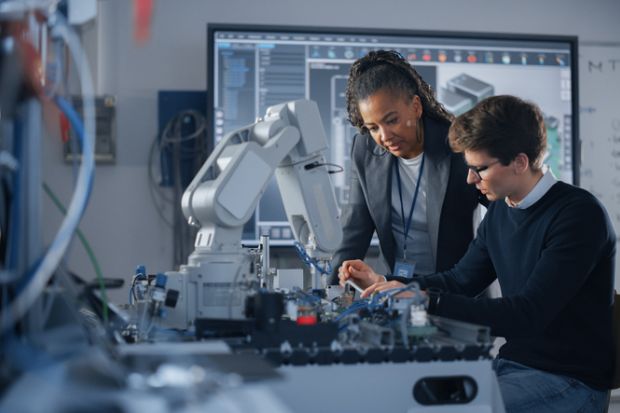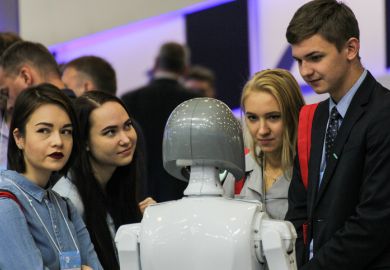More one-on-one time between teachers and students, real-time translations as lecturers speak and the ability to predict students’ needs are some of the ways artificial intelligence can personalise higher education, digital learning experts have said.
However, a lack of synchronised data to train machine learning systems and low levels of digital literacy were seen as holding the sector back.
Using chatbots, employing Outlook to schedule study times or getting Grammerly to help structure an essay are all part of the “first wave” of AI in higher education, Elizabeth Ellis, head of the School of Digital Teaching at Arden University, told Times Higher Education’s Digital Universities UK event.
Making the leap to the “second, third, fourth or fifth wave” will move universities from personal learning environments that are mostly used for skills development and learn-as-you-go courses to “genuine personalisation”, she added.
“Genuine personalisation with generative AI is going to be about everything moving to the students depending on what they need. And we’re not ready for that yet,” Ms Ellis said.
“But if we start to understand and recognise AI for what it is right now – which are useful tools and functions that are already here: you use them every day, and our students use them every day – we’ll hopefully inch down that road.”
Data literacy and an understanding of AI processes will be necessary for faculty to support students in using generative AI systems, she added.
“We have a responsibility to make sure our students are using these tools in the best possible way.”
Creating AI policies that are strict enough on plagiarism and academic misconduct but loose enough to progress its use was “the most challenging thing universities face”, Ms Ellis told the event at the University of Leeds. “How can we put enough space around the regulations that we’re putting in place…rather than just slamming everything down?” she asked.
The right approach will accommodate students who use AI responsibly, she said. “Not because we’re beating them to it but rather because this is the new reality.”
Harin Sellahewa, dean of the Faculty of Computing, Law and Psychology at the University of Buckingham, said that after rapid advancements in AI, universities are “very much in the stage of running around like a headless chicken”.
“The problem is that AI is developing far faster than we can comprehend. I’m not sure if we’ll ever be ready,” he said. “Right now, what we’re doing is trying to get the data correct. Without that, none of this will work.”
He described problems predicting individual learning outcomes using students’ exams and attendance data even before the arrival of generative AI programmes such as ChatGPT. “The programmes change, modules change, assessment weighting changes – so all the past data used to train machine learning were no longer relevant.”
Joanna Stroud, head of online learning at UCL, said personalised learning should be at the heart of education; however, workloads prevent educators from delivering it.
“Whether you are teaching in a bricks and mortar building or online, you cannot do everything for everybody. It’s simply impossible. And as AI becomes more sophisticated, we do need to be looking to it to take on some of the heavy lifting for teachers.”
Basic grading and assigning marks, and reviewing data to analyse student performance are a few of the tasks that could be handled by AI to free up teachers to spend more time with students, she said.
However, the rapid development of generative AI systems had caught UCL off guard, especially on assessment design, Ms Stroud conceded.
After the institution’s huge shift during the pandemic from running “thousands and thousands of exams annually” at London’s ExCel centre to enabling digital assessment, the risk of AI to exam credibility has required another radical rethink, she said. “We’re going back to the drawing board and doubling down our efforts.”
Speaking with THE at the event, Wei Li, vice-president and general manager of artificial intelligence and analytics at Intel, said AI tools presented a huge opportunity for students to learn better, but he said universities were in the very basic stages of digital transformation.
“If you want to use AI capability, it requires much more digital change than the kind of capability you have here,” he said. “There are many things universities can do, I just don’t know whether they’re set up to do them.”




